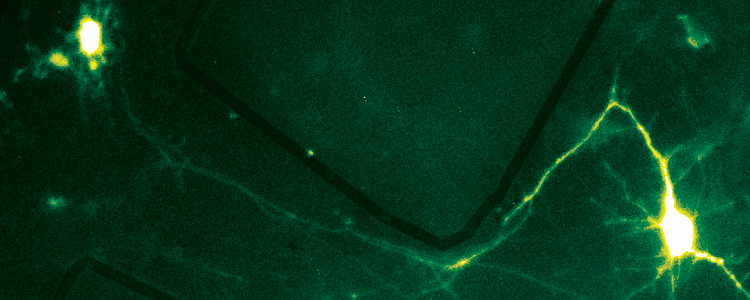I’ve been working extensively in how spontaneous and collective activity emerges in young neuronal cultures. How does a culture transition for individual and isolated firings into a collective mode? And what is this mode?
We’ve found that early collective activity is dominated by waves that nucleate at specific sites of the culture and propagate very rapidly (with an increasing speed during maturation), and these waves are followed by long periods of silence or very low activity. More importantly, these sites are specific (from culture to culture): there’re preferred zones in the system where waves nucleate, and these are not correlated with any local properties of the network (firing rate, density, connectivity, clustering, …). There also appears to be no correlation betweeen successive waves, each being independent of the previous one.
We were puzzled by this process. The waves are quite periodic (the inter-wave interval is highly peaked at a specific frequency), yet they are uncorrelated in their initiation sites. If a process is driven by noise, i.e., isolated firings, you expect it to have a characteristic time with exponential-like distributions, yet in this case it appears to be periodic!
By building accurate computational models of this process we were able to unveil its mysteries (at least some). The periodicity is dominated by synaptic depression, i.e., after a wave neurons’ synapses are depleted, and need a time to recover, which can be of the order of seconds (or even minutes). But that’s not the main issue, we found that this is coupled to a process of noise amplification, that we call noise focusing, in which isolated firings propagate throughout a network and are able to be amplified in a time scale of the order of the firing frequency of a single neuron! More interestingly, this amplification was not related to any local property of the system (it’s not neurons firing with a higher frequency, or with a higher connectivity), it is a property that arises from the complex interplay between the network topology and its dynamics. The amplification occurs through specific network pathways that focalize in specific regions of the culture. It is in these regions where waves can nucleate and then propagate.
In the video above you can see what is going on right before a wave nucleates in a simulated network of 5x5mm2. In each color you can see a different avalanche (an avalanche is a cascade of activity, i.e., causally connected firings), so if you see simultaneously avalanches of different colors it means that there’s no causal connection between them. Also, it might look like there’s a lot of activity, but keep in mind that there are thousands of neurons in there, and you only see the ones firing (in fact, each neuron will fire on average only once or twice before a wave). If you keep looking, at around 500ms a white avalanche will appear. This is going to be a special avalanche, this activity cascade is going to fully develop into a wave. Although there have been many avalanches before, they are what we call background avalanches, they do not do much. But at some point, the activity in one of these avalanches is going to be amplified through specific network paths, and its activity is going to increase exponentially until a wave is formed, the white, ignition avalanche. When the wave is fully developed we do not show the causal links (lines) anymore since there are too many! These amplification paths are the ones that depend extremely on the interplay between the topology and the dynamcis, and are the ones that give rise to specific nucleation sites in the system.
If you want more (and accurate) details you can read the main paper:
http://javierorlandi.com/?p=166
I have also worked in studying spontaneous activity in patterned cultures, i.e., cultures grown in arbitrary geometries. In cultures, geometry is what shapes the connectivity profiles and ultimately activity. So instead of using morphogen gradients and other developmental tools found in vivo, you can modify and study connectivity in vitro by constraining neuronal growth at will. This research is still in progress.
Criticality and Self-Organized Criticality has also attracted my attention and we have some very nice results with simple models, but there’s still work to do.
